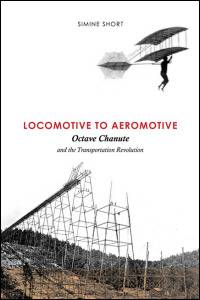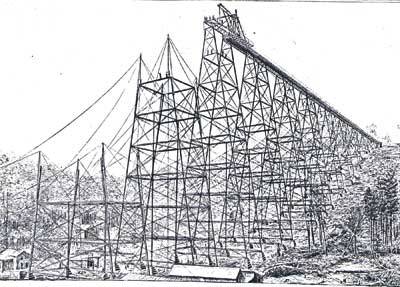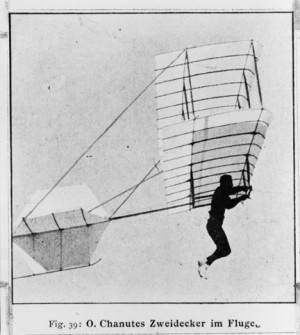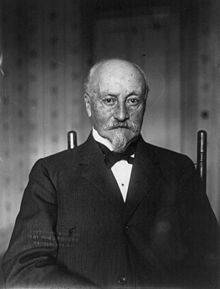 Although I grew up just down Route 45 from the former Chanute Air Force Base, I didn’t know much about Octave Chanute himself until recently, when I read Simine Short’s biography Locomotive to Aeromotive: Octave Chanute and the Transportation Revolution, published this year by the University of Illinois Press.
Although I grew up just down Route 45 from the former Chanute Air Force Base, I didn’t know much about Octave Chanute himself until recently, when I read Simine Short’s biography Locomotive to Aeromotive: Octave Chanute and the Transportation Revolution, published this year by the University of Illinois Press.
Chanute, who lived from 1832 to 1910, was a widely accomplished engineer involved in an astonishing number of different aspects of the development of the U.S. transportation network as the nation industrialized and expanded westward in the 1800s. Among other things, Chanute was a railroad engineer, designed bridges and stockyards, developed methods for preserving wood, and was a key figure in establishing professional engineering organizations. Near the end of his life, Chanute became active in aviation, and worked with many early aviation pioneers, including the Wright Brothers (Wilbur Wright contacted Chanute after reading Chanute’s book Progress in Flying Machines).
A few of his design and engineering achievements include designing the Kinzua Viaduct in Pennsylvania, designing the Chicago and Kansas City stockyards, and working as a railroad engineer on a number of U.S. railways, including the Chicago and Alton.

Kinzua Viaduct
Documenting Chanute’s many achievements would take a long time ― and Short has taken that time in her book. She follows Chanute from his childhood in antebellum Louisiana to his time as a young apprentice engineer with the Hudson River Railroad to his final years as an internationally respected figure in engineering, aviation, and technology in general.
Short responded to my questions about Chanute and his work by email.
Mark Laughlin: In your book, you include the following quote from Chanute, who designed many major bridges:
The remark is sometimes heard that bridges and viaducts are great eyesores to the artistic public, and that engineers are rectangular utilitarians who pay no attention to looks… How far an engineer will be justified in spending other people’s money on ornament will depend upon the circumstances, but as wealth and taste have increased, there seems to be a disposition on the part of capital to take a more liberal view of this matter.
It’s clear that aesthetics were important to Chanute; to what extent throughout his career was he able to overcome cost restraints to make his designs “look” the way he would have ideally had them look?
Simine Short: Looks were important, but I do not think that Chanute got carried away spending someone else’s money to improve the overall look. I think he used his engineering skills to design bridges the most efficient way without jeopardizing safety on one side and introducing an aesthetic view on the other side.
Laughlin: From Locomotive to Aeromotive, concerning the Chicago Union Stockyards, which were designed by Chanut and opened in 1865:
Chanute had combined his talents in designing railroads and now stockyards to the benefit of farmers shipping and selling their cattle. The Chicago Union Stock Yards became a pride of the city and operated successfully for 106 years, closing in 1971. The rugged limestone gate at the entrance to the yards at Exchange Avenue and Peoria Street is a visual reminder of Chicago’s past supremacy in the livestock and meatpacking industries.
The Chicago Stock Yards were a marvel of design and industry; however, labor and sanitary conditions in the meatpacking plants, made possible by the opening of the stockyards, were often atrocious, as famously documented in Upton Sinclair’s 1906 novel The Jungle. Chanute was very old by the time that novel came out, but did he ever comment on conditions in the stockyards? Did he see any “dark sides” to any of the other projects of industrial expansion (railroads, etc.) that he worked on throughout the latter half of the 1800s?
Short: I think that Chanute was concerned about the “by-products” of the industrial revolution. He was concerned about the animals’ well-being while in transit (either at the yards or in the railroad cars), but he also knew that meat was needed for the growing population. You will notice that Chanute became involved with refrigerated cars later in his career. As far as I can tell, he did everything possible (from his side, as the civil engineer in charge of the construction) so that animals were treated the best he knew how. But you also have to keep in mind that low cost laborers did most of the meatpacking work. Many of them had little respect for the life of animals or even other human beings. And as you probably know, most of the atrocious conditions developed long after Chanute had left the railroad business. Interestingly, a visit to the Chicago stockyards was frequently on the list of places to see when the Western Society of Engineers scheduled sightseeing tours, but I have not yet seen Chanute’s name as one who joined the tours to the yards. This indicates to me that he probably did recognize the “dark sides,” but he probably also knew that he could do little about them.
Laughlin: From Locomotive to Aeromotive:
Department of Forestry statistics forecast in 1880 that the nation’s supply of white pine would be exhausted in eleven years and hardwood within twenty-five. Chanute was arguably the first American to show his concern for preserving resources; he demonstrated the commercial feasibility of preserving wood to slow deforestation. Gradually, railroaders recognized the need to make timber last as long as possible and they realized that increasing the life of ties decreased the cost of track repair.
A cynic might claim that Chanute’s concern for saving trees was merely a self-interested one, since he ran a business that specialized in preserving railroad ties. However, as you point out, any mention of, or concern with, conservation at all is remarkable in the context of his times. How much of an influence would you say he had in getting people to start thinking in what we now call “green” ways?
Short: I do not think that Chanute’s interest or concern in saving trees was self-interest, as he promoted the saving of trees long before he joined Joseph Card in the wood preserving business.
Please take a look at page 59 of my book:
Requiring immense supplies of ties and lumber for bridges in the construction process, Chanute wondered about future sources of hardwood as the road crossed sparsely forested eastern Kansas. A recently passed Kansas legislative act encouraged the growing of timber, so Chanute suggested to the president of the Border Tier Road, Horatio Hunnewell, to plant a variety of trees in two 640-acre sections to determine the best and fastest growing. The company then collected a state-sponsored bounty and eventually supplied trees for telegraph poles and ties to all the prairie railroads. These early concerns for natural resources could well have been the genesis for Chanute’s timber preservation experiments and business a decade later.
Did he influence in what we call the “green way” today? I believe so, but the “green way” is a relatively recent development, and more than a century has passed since Chanute promoted the preservation of wooden railroad ties. He mentioned in several letters that railroad men can save money (not have to replace railroad ties in the tracks as often) by spending money (on preserving ties). I think he combined a businessman’s attitude with necessity: wood became more expensive as it became more scarce, thus preserving wood made commercial sense:
Card knew the business of timber treating, loved experimenting, and held patent rights for the Wellhouse process, while Chanute knew the right people, how to handle the promotion of the business, and how to convince railroad men to conserve natural resources (Locomotive to Aeromotive, pg. 141).
Laughlin: From Locomotive to Aeromotive:
Chanute’s newest “side issue,” mechanical flight, provided more exciting challenges, as he believed the problem of flight could only be solved through an interchange of thoughts. Even though work in aviation would clearly cost him money rather than make him money, Chanute delved deeper into the fascinating topic of flying machines, the collaborative opportunity and the technological excitement seemed to be waiting in his final foray of life.
 Chanute served as someone who brought together people and ideas in the pursuit of powered flight. He also contributed engineering and design ideas of his own, such as his “strut-wire” braced wing structure. In your opinion, was his contribution to aviation more as a connector of people and conduit of ideas, or as an engineer and designer of flying machines in his own right?
Chanute served as someone who brought together people and ideas in the pursuit of powered flight. He also contributed engineering and design ideas of his own, such as his “strut-wire” braced wing structure. In your opinion, was his contribution to aviation more as a connector of people and conduit of ideas, or as an engineer and designer of flying machines in his own right?
Short: I believe that Chanute did both. By bringing people together, publicizing what was discovered, and sharing information, he allowed (or guided?) others to think in the proper direction. Thus, he gave guidance to newcomers, and ― as you know ― anyone who enters the field as a newcomer usually has fresh ideas. This is what Chanute wanted to encourage and distribute.
And the Chanute-type biplane structure was a starting point for many future engineers. Until 1896, no one had thought of using a larger surface for the tail structure, which made the aircraft more stable. This is what was needed for the initial breakthrough. Yes, I believe that his aeronautical contribution was for real. If you look at the airplanes built around the world during the next decade, almost all were biplane structures, similar to the Chanute-type.
Laughlin: Chanute, as quoted in Locomotive to Aeromotive, concerning whether or not the Wright Brothers deserved to get a patent based on the concept of “wing-warping,” which they claimed as their own:
As to the wing-warping patent under which they demand damages from others for alleged infringement, this is not an original idea with them. On the contrary, many inventors have worked on it from the time of Leonardo da Vinci. Two or three have actually accomplished short glides with the basic warping idea embodied in their machines.
Chanute, as depicted in your book, stands out from many of his contemporaries in early aviation in that he seems more interested in achieving powered flight, period, than in getting credit or money for doing so. In this way, he differed from the Wright Brothers, who were very concerned with both credit and profit.
In your opinion, did Chanute’s attitude of putting the goal of powered flight before any personal considerations possibly lead to him being assigned a lesser role in the history of flight than he truly deserves?
Short: I am not sure if Chanute had the goal of “powered flight.” He dreamt more of flying without an engine, i.e. soaring from “power” that came from nature. He wrote several papers where he discussed this in detail. Maybe this is also a “green way” of thinking? Also, I think Chanute was a bit “old-fashioned” in his thinking, as he believed in the good of contributing and volunteering. He was happy to see younger engineers grow and achieve fame and fortune. And he did not believe that he played a “lesser role” in the overall evolution process; he knew that modern aviation started out with his design of the airplane structure. That was good enough for him.
He really did not need to worry about profit, as I think he had acquired enough money to live comfortably. He just wanted people to remember that it was him who helped in the early days of aviation’s beginning. But he did appreciate it, especially in the last few years of his life, when someone thanked him.
I believe Hudson Maxim summed up Chanute’s character the best:
Octave Chanute was the veritable father of aviation, and he was always, in all things, a vedette of progress. He was one of those whom duty send far to the fore, where, unaided and lonesome, they make their landmarks, beckon their fellows to follow, and move further on; and, when the world comes up, then, and not until then, are their landmarks seen to be true and their labor found to be worthwhile… Chanute was one of those rare intellectual giants big enough and generous enough to endow other inventors and workers with his knowledge and to lend a hand to help them utilize it, and all without jealousy or envy. Aviation was a thing dearer to his heart than any self-greatening. It is gratifying to know that before his lamp of life went out he had the satisfaction of seeing fairly accomplished that master achievement which he had so generously patronized and for which he had so long labored and prayed-the conquest of the air… Always it has been a devoted few who have stood in the vanguard and fought the hard fight of progress. One of such few was Octave Chanute. He belonged to the true nobility of brains.









 Octave Chanute was the veritable father of aviation, and he was always, in all things, a vedette of progress. He was one of those whom duty send far to the fore, where, unaided and lonesome, they make their landmarks, beckon their fellows to follow, and move further on; and, when the world comes up, then, and not until then, are their landmarks seen to be true and their labor found to be worthwhile… Chanute was one of those rare intellectual giants big enough and generous enough to endow other inventors and workers with his knowledge and to lend a hand to help them utilize it, and all without jealousy or envy. Aviation was a thing dearer to his heart than any self-greatening. It is gratifying to know that before his lamp of life went out he had the satisfaction of seeing fairly accomplished that master achievement which he had so generously patronized and for which he had so long labored and prayed-the conquest of the air… Always it has been a devoted few who have stood in the vanguard and fought the hard fight of progress. One of such few was Octave Chanute. He belonged to the true nobility of brains.
Octave Chanute was the veritable father of aviation, and he was always, in all things, a vedette of progress. He was one of those whom duty send far to the fore, where, unaided and lonesome, they make their landmarks, beckon their fellows to follow, and move further on; and, when the world comes up, then, and not until then, are their landmarks seen to be true and their labor found to be worthwhile… Chanute was one of those rare intellectual giants big enough and generous enough to endow other inventors and workers with his knowledge and to lend a hand to help them utilize it, and all without jealousy or envy. Aviation was a thing dearer to his heart than any self-greatening. It is gratifying to know that before his lamp of life went out he had the satisfaction of seeing fairly accomplished that master achievement which he had so generously patronized and for which he had so long labored and prayed-the conquest of the air… Always it has been a devoted few who have stood in the vanguard and fought the hard fight of progress. One of such few was Octave Chanute. He belonged to the true nobility of brains.